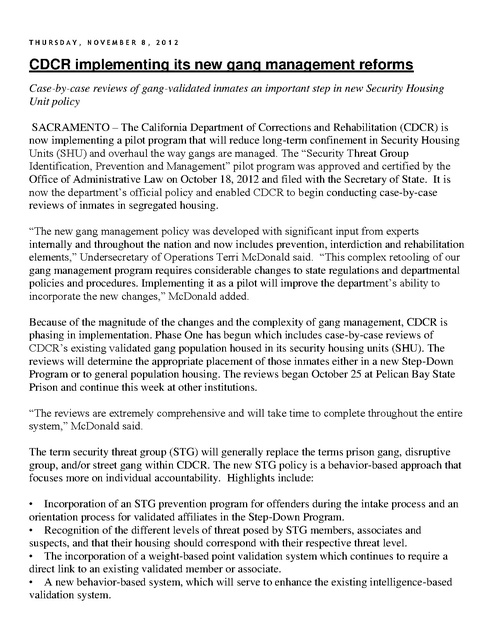Revised Gang Certification Policies, Nov, CDCR, 2012
Download original document:

Document text

Document text
This text is machine-read, and may contain errors. Check the original document to verify accuracy.
THURSDAY, NOVEMBER 8, 2012 CDCR implementing its new gang management reforms Case-by-case reviews of gang-validated inmates an important step in new Security Housing Unit policy SACRAMENTO – The California Department of Corrections and Rehabilitation (CDCR) is now implementing a pilot program that will reduce long-term confinement in Security Housing Units (SHU) and overhaul the way gangs are managed. The “Security Threat Group Identification, Prevention and Management” pilot program was approved and certified by the Office of Administrative Law on October 18, 2012 and filed with the Secretary of State. It is now the department’s official policy and enabled CDCR to begin conducting case-by-case reviews of inmates in segregated housing. “The new gang management policy was developed with significant input from experts internally and throughout the nation and now includes prevention, interdiction and rehabilitation elements,” Undersecretary of Operations Terri McDonald said. “This complex retooling of our gang management program requires considerable changes to state regulations and departmental policies and procedures. Implementing it as a pilot will improve the department’s ability to incorporate the new changes,” McDonald added. Because of the magnitude of the changes and the complexity of gang management, CDCR is phasing in implementation. Phase One has begun which includes case-by-case reviews of CDCR’s existing validated gang population housed in its security housing units (SHU). The reviews will determine the appropriate placement of those inmates either in a new Step-Down Program or to general population housing. The reviews began October 25 at Pelican Bay State Prison and continue this week at other institutions. “The reviews are extremely comprehensive and will take time to complete throughout the entire system,” McDonald said. The term security threat group (STG) will generally replace the terms prison gang, disruptive group, and/or street gang within CDCR. The new STG policy is a behavior-based approach that focuses more on individual accountability. Highlights include: • Incorporation of an STG prevention program for offenders during the intake process and an orientation process for validated affiliates in the Step-Down Program. • Recognition of the different levels of threat posed by STG members, associates and suspects, and that their housing should correspond with their respective threat level. • The incorporation of a weight-based point validation system which continues to require a direct link to an existing validated member or associate. • A new behavior-based system, which will serve to enhance the existing intelligence-based validation system. • A new STG behavior-based disciplinary matrix, which will provide for additional procedural due process safeguards and a system of individual accountability. • A new STG Classification Committee, which will provide an additional level of due process review and affirm initial STG validations. • STG associates – a majority of inmates housed in SHUs – will no longer be considered for direct administrative placement into a SHU based solely upon their validation to an STG unless there is a corresponding confirmed disciplinary behavior at the time of the original validation. • Implementation of an incremental three- to four-year Step-Down Program, which by design will replace the existing six-year inactive review process for validated STG affiliates. • The Step-Down Program will be an individual behavior-based program for STG affiliates that will provide graduated housing, enhanced programs and interpersonal interactions as well as corresponding privileges and personal property enhancements. McDonald said Phase Two of the STG pilot program will include the implementation of the new validation process and will begin early next year. Case-by-case reviews of validated affiliates housed in smaller Administrative Segregation Units will also be implemented with the new validation system. “These changes support our goals to reduce long-term SHU confinement, provide alternatives for inmates who want to disassociate from a criminal gang lifestyle, maintain safety in our prisons and communities and have a more effective system that complies with national best practices,” McDonald said. CDCR manages about 3,100 STG (gang) members and associates in security housing units. About 20 percent of these offenders are validated STG members, who maintain a high level of influence over subservient street gangs and other individuals incarcerated within the prison population and represent a significant threat to the safety of others and institution security. The remaining 80 percent are validated STG associates, who under the direction of STG members assist in carrying out illicit, disruptive, violent and/or criminal activities in the operations of these criminal organizations. California Penal Code Section 5058.1 grants CDCR the authority to implement pilot programs. The “Security Threat Group Identification, Prevention and Management” pilot has the force of law and will expire by operation of law in two years or on October 18, 2014 unless adopted by CDCR into the California Code of Regulations using the process described by the Administrative Procedure Act.

